Entries in Columbia County (13)
11/9/11 More photos of field fragmentation in We Energies Columbia County wind project AND Notes on Big Wind votes from around the country.
NOTE FROM THE BPWI RESEARCH NERD: These recent photos of the We Energies wind project in Columbia county were taken by Jim Bembinster. They show how the siting of wind turbines has resulted in field fragmentation. What is not visible in the photos is the severe soil compaction that will affect crops.
CLICK HERE to see more pictures from this project, and to download larger versions of these files



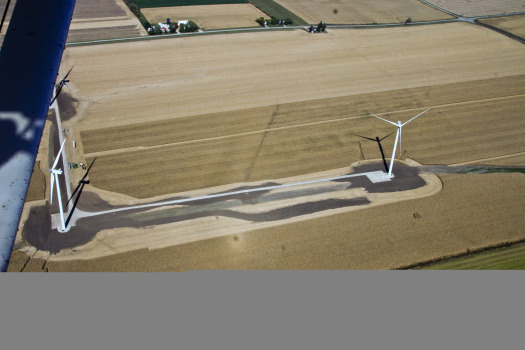
Michigan
THREE RECALLED IN JOYFIELD TOWNSHIP
TRAVERSE CITY — Voters have recalled three Joyfield Township officials they believe are too closely tied to a controversial wind project.
Supervisor Larry Lathwell, Clerk Gary Lathwell, and Treasurer Debra Lindgren have been recalled leaving just two members left on the board.
The trio signed leases with Duke Energy to have turbines placed on their property. and some residents say its a conflict of interest.
The Benzie County Election Commission, which is made up of the county’s clerk, probate judge, and treasurer will now chose an interim board member for the township. That will give them enough officials to vote for new members.
Whoever is chosen will serve until the next election in February 2012.
Continue reading...www.upnorthlive.com
Wind Turbine Opponents score victories in two township elections.
In Riga Township, residents voted 440 to 236 to uphold an ordinance that wind turbine supporters say effectively bans turbines in the township.
The vote means that the turbine ordinance enacted July 6 by the township board will stay in effect. That ordinance requires turbines to be no less than four times their own height from non-participating properties and also limits noise levels to 40 decibels between 10 p.m. and 6 a.m. and 45 decibels between 6 a.m. and 10 p.m.
In Ogden Township, the candidates backed by wind turbine opponents won the races for township supervisor and township clerk.
Continue reading... Daily Telegram
Maine:
Ban on large wind turbines approved in Brooksville:
BROOKSVILLE, Maine — Residents here voted overwhelmingly on Tuesday to approve a wind power ordinance that likely means the Hancock County town will be off-limits to commercial wind energy facilities....
Additionally, the ordinance adopts noise standards for wind turbines that are stricter than those currently required by the state. Turbines will be prohibited from generating in excess of 35 decibels for any continuous, 5-minute period — except during unusual weather events — as measured from neighboring properties. That standard is also more stringent than new, 42-decibel standards proposed by the Maine Board of Environmental Protection.
Continue reading... bangordailynews.com
Cushing approves new wind turbine ordinance
Cushing — Cushing residents voted Nov. 8 to enact a new town Wind Turbine Ordinance, limiting wind turbines to a maximum of 80 feet tall.
Residents supported the proposed ordinance by a vote of 273 to 181.
Under the ordinance wind turbines that meet the height requirement will be required to meet sound limits at the property lines. These limits will not support large commercial wind turbine installations.
Continue Reading.....Herald Gazette, knox.villagesoup.com
Rumford wind ordinance OK'd
RUMFORD — Third time’s a charm proved true Tuesday when a majority of voters overwhelmingly approved the third proposed wind ordinance in two years.
The tally was 1,137 “yes” to 465 “no,” Town Manager Carlo Puiia said. Fifty ballots were blank, meaning those voters didn’t select either answer.
The vote essentially kills any wind farms coming to Rumford until technology improves or the ordinance gets amended, he said.
Continue reading.....Sun Journal, www.sunjournal.com
New York State:
Hirschey defeats White in Cape Vincent; victory for anti-wind group
Regarding Mr. Hirschey’s plan to pass a moratorium on wind development to create a wind zoning law, Mr. White said that plan would “backfire” on the new town board because wind farm developers are likely to submit another application for the state to consider under the state-controlled Article X, essentially stripping Cape Vincent of home rule.
“I’m not upset,” said Mr. White, who as co-owner of White Farm holds contracts with both the St. Lawrence Wind Farm and the Cape Vincent Wind Farm projects. “I think the people of Cape Vincent will regret this later.”
Continue reading: watertowndailytimes.com
11/7/11 Look what they've done to our fields, Ma: Wisconsin's newest wind project as seen from the air AND Wind developers in Illinois are no better
THE VIEW FROM ABOVE: FARM FIELD FRAGMENTATION IN WE ENERGIES GLACIER HILLS WIND PROJECT IN COLUMBIA COUNTY, WISCONSIN.
Photos by Jim Bembinster
Photo by Jim Bembinster, Columbia County WI 2011
NOTE FROM THE BPWI RESEARCH NERD: Wisconsin farmers sign on with wind developers because it seems like easy money. They are told they can farm right up to the turbine foundations. They are told about a quarter acre of land will be taken out of production for each turbine.
What they are not told is there will be access roads and trenching for each turbine that will go where the developer wants them to go, crossing at diagonals in the middle of fields, and in some areas compacting the soil so badly crop production is affected and drain tiles are crushed. The farmer is not told that the they've given the wind company the right to use the land as it wishes. It's all in the contract, if you know how to read a contract, or take that contract to a lawyer to read over for you.
The photos below were recently taken by Jim Bembinster. They show a wind project in Columbia County being built by We Energies and the newly fragmented farm fields.
To see larger versions of these pictures CLICK HERE
Better Plan will be posting more photos by Jim Bembinster of the Columbia County We Energies wind project in upcoming days

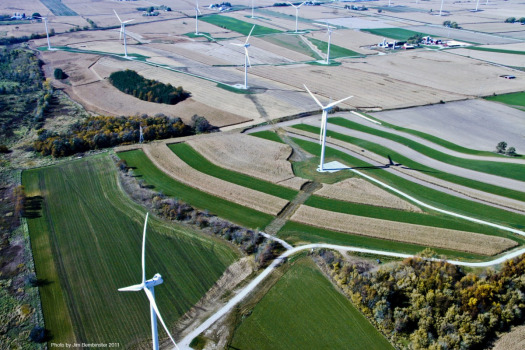
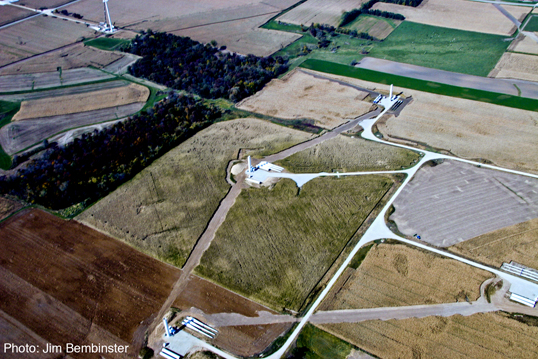 Photo by Jim Bembinster, 2011 We Energies Glacier Hills wind project, Columbia County WI
Photo by Jim Bembinster, 2011 We Energies Glacier Hills wind project, Columbia County WI
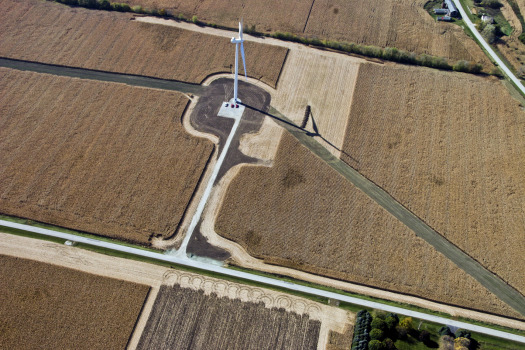
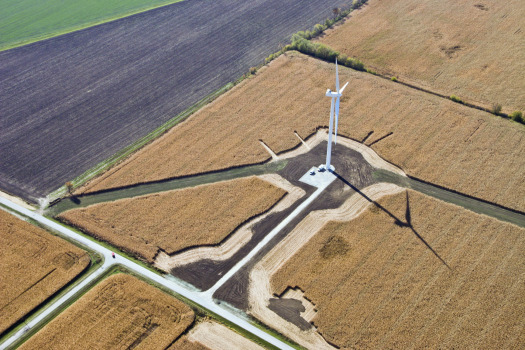

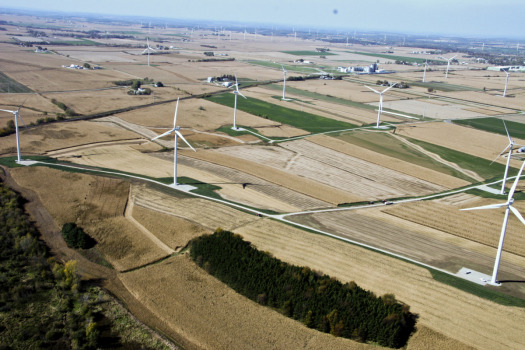
FROM ILLINOIS
FARMER UPSET WITH WIND COMPANY
BY DAVID GIULIANI, www.saukvalley.com 7 November 2011 ~~
COMPTON – Gale Barnickel, a Compton farmer, says he’s not against the wind farm being built in his area.
He and his parents decided against having turbines on their farm, but he said they respected the rights of others to have them.
“We have no problems with what the neighbors want,” he said.
Now, he is alleging that wind energy company Goldwind USA has been repeatedly trespassing on his family’s property. And that has resulted in crop damage, he said.
The property is well posted, he said, so trespassers knew what they were doing.
He brought the allegations to last week’s meeting of the county Zoning Board of Appeals, which is recommending changes to the county’s wind energy ordinance.
On Sunday, Goldwind admitted that its contractor mistakenly crossed into Barnickel’s land.
“When they realized this, they contacted Mr. Barnickel to apologize and address the issue,” spokesman Colin Mahoney said in a statement.
Since then, he said, the contractor has taken “concrete steps” to clearly mark Barnickel’s land, so it’s more visible to construction crews.
At last week’s meeting, those attending expressed concern about Barnickel’s situation. Another wind company weighed in, saying such things shouldn’t happen.
Goldwind, a subsidiary of a Chinese company, is putting up 71 turbines in an area of roughly 6 square miles near Compton in eastern Lee County. It hopes to finish the project – known as Shady Oaks – by year’s end.
In September, a farmer reported that the company had built a road through his cornfield that, he said, was unnecessary. He and another farmer pointed out roads and easements that, they contend, the company mistakenly built through faulty planning.
Other paths for transmission lines were curved, when a straight line would have taken out less cropland, they said.
Unlike Barnickel, those farmers allowed wind turbines on their property, which means they’ll get money every year from the company. In the contracts, Goldwind has agreed to compensate farmers for cropland lost in the construction project.
Barnickel has no agreement with Goldwind.
“Something has to be done to control these guys,” he said. “We try to be neighborly, but we’ve caught them mowing down our crops. They’re cutting corners wherever they can.”
Board member Tom Fassler asked Barnickel whether he had called authorities. The farmer said he had filed two reports with the Lee County Sheriff’s Department, but that it was a waste of taxpayers’ money to keep calling out the sheriff.
“It’s nerve-wracking being pushed around,” Barnickel said. “Why should I have to put up with that?”
“You shouldn’t,” Fassler responded.
Franklin Grove Village President Bob Logan, who attended the Zoning Board meeting, said that was what happens when wind farms are rushed through.
“You’re seeing the rush in the southern part of the county,” he said.
Logan warned that the county may face class-action lawsuits because “rights aren’t being respected.”
“It’s not a level playing field,” he said. “We are here to level it.”
John Martin of Mainstream Renewable Power, which plans a three-county wind farm, told Barnickel that “it’s just not right. No company should operate like this.”
The next day, Barnickel’s wife, Christina Barnickel, said in an interview that the state should fine companies that trespass.
“We have tried to stop them and showed them where the property line is,” she said. “You put so much hope and investment in the crop, and then someone knocks it over. It rubs you wrong.”
Mahoney said the company would continue to work hard to make sure it is a responsible neighbor throughout the rest of the project. He noted that the project is complex, with more than 100 workers busy building access roads, erecting turbines and delivering components on site.
“Despite this complexity, Goldwind is committed to minimizing the impact on the local community, including both participating landowners and neighboring landowners alike.”
NEXT FEATURE:
FROM WISCONSIN
More images of field fragmentation in the Columbia County We Energies wind project.
Photos by Jim Bembinster, 2011
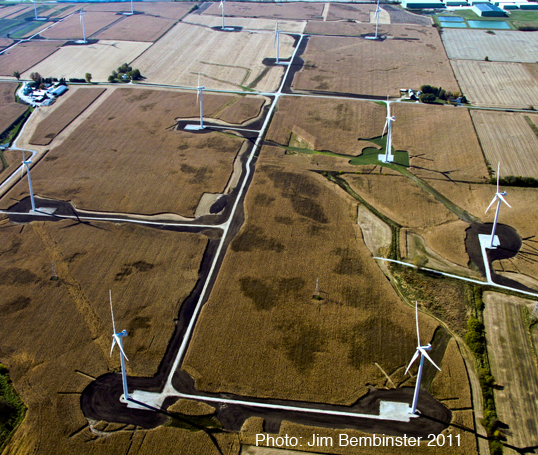
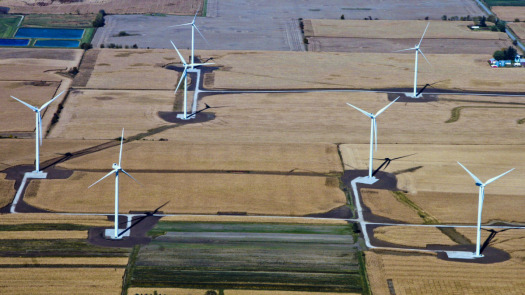
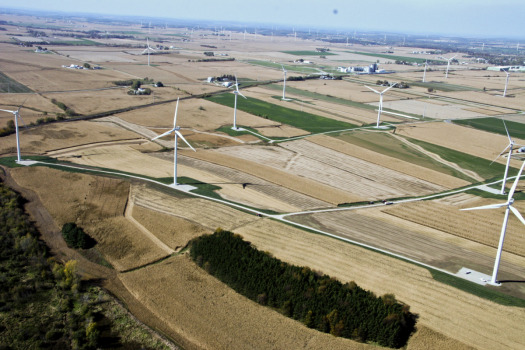
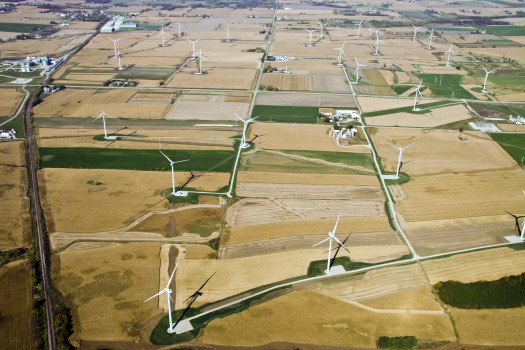
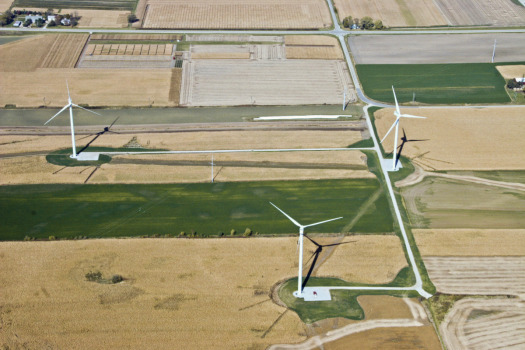

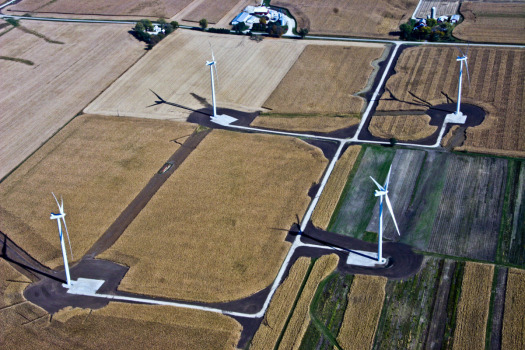

7/6/11 Want to buy a house in a wind farm? Why not? AND What problem with wind power?
STUDY FINDS WIND TURBINES CAN BE TOUGH ON NEIGHBORS PROPERTY VALUES
READ ENTIRE STORY AT SOURCE: The Post-Standard, www.syracuse.com
July 6, 2011
By Charles McChesney
Potsdam, NY — Wind farms reduced the value of nearby real estate in two Northern New York counties, but not in a third.
Martin D. Heintzelman and Carrie M. Tuttle, of Clarkson University, studied 11,331 real estate transactions over nine years and found that the value of property near wind turbines dropped in Clinton and Franklin counties. But they found no impact in Lewis County.
The paper they produced, “Values in the Wind: A Hedonic Analysis of WindPower Facilities,” hasn’t been finalized, Heintzelman said, but an earlier version has been shared by opponents of wind farms. (Hedonic is a economic term referring to estimating value or utility).
A March version of the paper, distributed by opponents of a wind-farm proposal for Cape Vincent in Jefferson County, found an overall decrease in values among properties neighboring wind turbines in Clinton, Franklin and Lewis counties.
But Heintzelman said the research was reviewed, and combining the counties, it turned out, “was not a reasonable approach.”
The refined findings are, he said, “somewhat more nuanced.”
Heintzelman said past research, including a study of Madison County, showed wind farms had little or no impact on real estate values. But he found that hard to believe.
“Anytime you put a large industrial or manufacturing facility in someone’s backyard,” he said, there is bound to be some impact.
So he and Tuttle, a graduate student, statistically analyzed real estate data, mostly from the state Office of Real Property Services.
They found that placing a wind turbine a half mile from the average property in Franklin or Clinton counties would result in a loss of property value of $10,793 to $19,046. The impact drops off as properties become more distant, he said. At the distance of three miles, the impact is $2,500 to $9,800.
But Lewis County, with the 321-megawatt Maple Ridge Wind Farm, was different. “Lewis County does not see negative impacts,” Heintzelman said.
Asked whether the study’s findings hold lessons for communities weighing wind-power projects, Heintzelman said it could be worth considering how those who have wind turbines near, but not on, their property might be compensated if they see their real estate drop in value.
Other than that, he said, “Sadly, no, I don’t think I have any specific advice.”
[Click here to download the study ,courtesy of National Wind Watch
THE REALITY OF WIND POWER
energy.aol.com 27 June 2011 By Margaret Ryan,
Wind turbines cost more to operate and maintain than planned, often have poor reliability, and place costly strains on other generators warns one early wind adopter, but so far the public is willing to bear the costs.
Kevin Gaden, wholesale power director for the Municipal Energy Agency of Nebraska (MEAN) and NMPP Energy, a public power consortium covering parts of Nebraska, Iowa, Wyoming and Colorado, detailed his members’ experiences at the American Public Power Association conference in Washington last week.
Gaden said his members decided a decade ago that renewable energy was coming and they wanted to gain experience in the sector. They found their customers embraced the idea, and readily agreed to pay more to get renewable power.
MEAN now gets 5% of its electricity from five wind facilities, including one in South Dakota that averages more than 40% capacity factor, far better than the U.S. average of 30%.
But Gaden warned a packed conference session that public perception of wind has not caught up with the realities of operating wind in a commercial generating system. While newer turbine designs and engineering have improved, he said, “Overall reliability is less than advertised.”
Turbines are still faulting on issues like finding the right lubricating oil for the Nebraska climate, Gaden said. Maintenance is costly because specialized equipment and personnel have to be brought to remote wind sites, making long-term relations with a reliable turbine supplier a must.
When they’re damaged by things like lightning strikes, repairs can require a crane that can reach the turbine, 200-300 feet above the prairie, at $1,000 an hour, he said.
State renewable energy credits, seen by renewables advocates as a way to compensate for higher costs, sell for $1 apiece and make little difference, he said.
As in other parts of the country, wind is often plentiful at night and not available during the day, and drops off during summer peaks, so wind power isn’t there when it is most needed. Gaden said the Great Plains winds track better with consumers’ winter demand.
But that wind variability, with wind often gusting and then calm in quick succession, puts a costly burden on other generators in the system, he said.
Less Than Zero
Interstate grid operators take day-ahead bids for hourly power and fill their anticipated needs with the cheapest bids first. But all generators are paid the same amount as the highest bid taken. Gaden said wind operators benefit from tax credits for every megawatt-hour generated, so they bid into the system at zero or less. That ensures their generation will be taken, and they will get the price paid conventional generators.
That means generation from baseload units is only partially bought, and sometimes large units have to cycle up and down to accommodate the wind. This type of operation makes them far less efficient than the consistent operation they were designed for, and the increased wear and tear raises maintenance costs.
Gaden noted grid operators, who must keep the power supply stable, are looking at creating regional “energy imbalance markets” to account for the extra costs of offsetting renewable variability. Gaden said federal researchers had estimated ancillary resource costs at $2 per megawatt-hour, but in Nebraska, it turned out to cost $4.60.
Gaden said he’d asked Department of Energy experts how much carbon emissions were saved by wind, net of the less efficient operation forced on conventional fossil units. The answer, he said, was “we don’t know,” but the experts acknowledged there is an impact.
In the future, Gaden said, his public power members will probably continue to buy small shares of electricity from large wind projects, as long as customers want it.
6/3/11 First comes the wind developer, then comes the met tower, then comes a lifetime of regret AND About that new wind developer poking around Spring Valley
 AN OPEN LETTER FROM A WISCONSIN FARMER WHO REGRETS SIGNING A WIND CONTRACT
AN OPEN LETTER FROM A WISCONSIN FARMER WHO REGRETS SIGNING A WIND CONTRACT
"By signing that contract, I signed away the control of the family farm, and it's the biggest regret I have ever experienced and will ever experience."
-Gary Steinich, Cambria, Wisconsin. June 2011
Sometime in late 2001 or early 2002, a wind developer working for Florida Power and Light showed up near the Wisconsin Town of Cambria looking to get in touch with someone at the Steinich family farm.
He wanted to talk to the landowner about leasing a bit of land for the installation of a met tower. He needed to measure the winds in the area for a possible windfarm and Walter Steinich's land looked like a good place to do it.
The wind developer seemed like a good guy to Mr. Steinich who was in his early 70's at the time. The money seemed good. A met tower didn't seem like a big deal. It was just a tall pole with some guy wires, and it was temporary. Mr. Steinich signed the contract.
That was nearly ten years ago. Mr. Steinich has since passed away and now his son, Gary, runs the farm. He's written an open letter to Wisconsin farmers about his experience with the wind company since then.
Photos below are of access roads and turbine foundations in various farm fields in the Glacier Hils project now under construction in Columbia County, Wisconsin
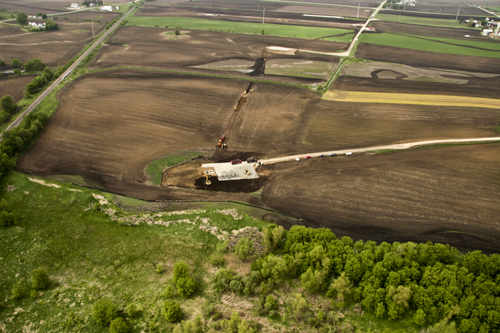 Turbine access road cutting diagonally across field in Glacier Hills project. May 2011
Turbine access road cutting diagonally across field in Glacier Hills project. May 2011
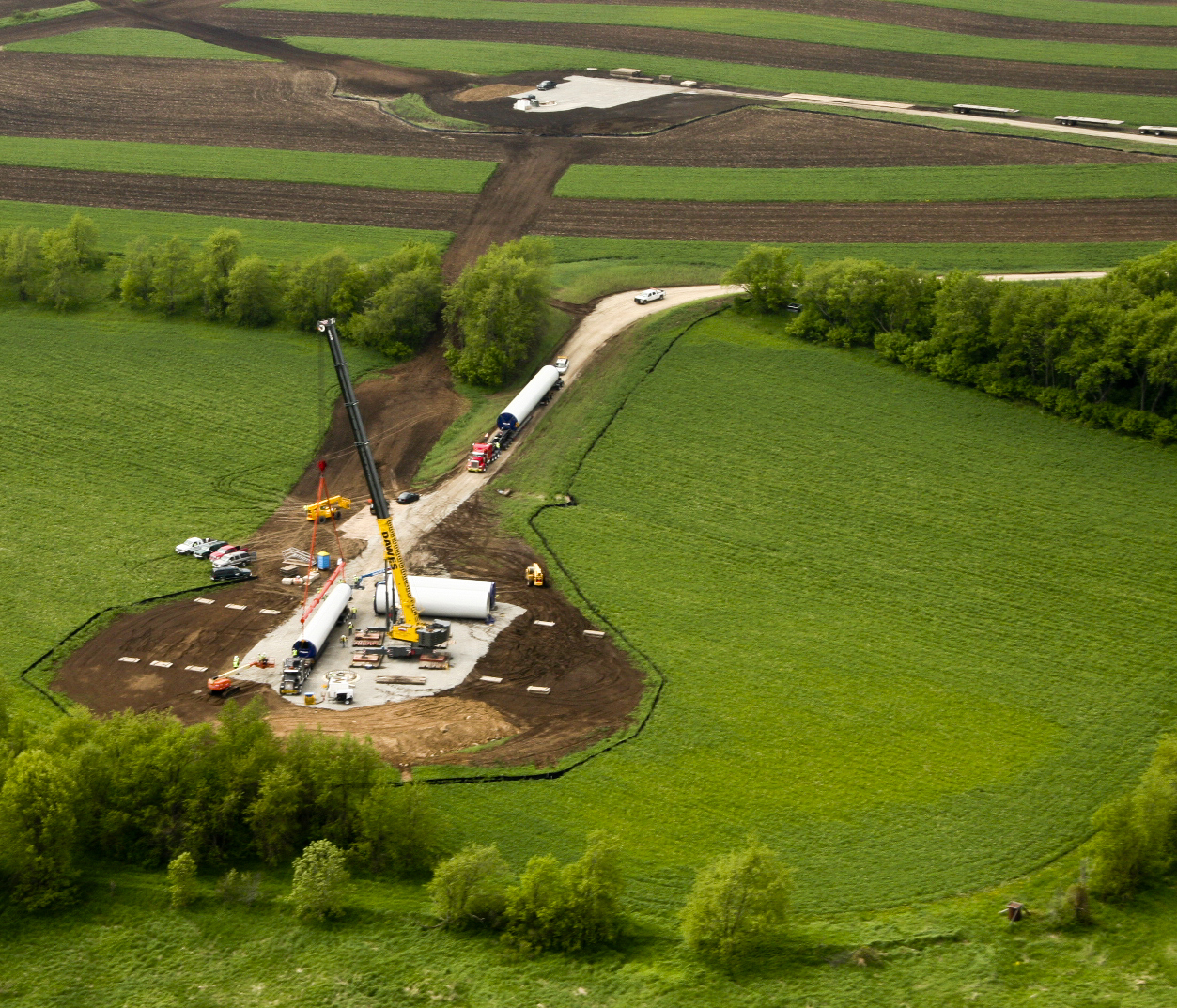
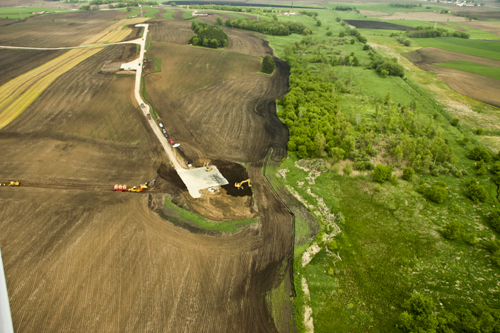
From One Wisconsin Farmer to Another:
This is an open letter to Wisconsin farmers who are considering signing a wind lease to host turbines on your land. Before you sign, I’d like to tell you about what happened to our family farm after we signed a contract with a wind developer.
In 2002, a wind developer approached my father about signing a lease agreement to place a MET tower on our land. My father was in his 70’s at the time. The developer did a good job of befriending him and gaining his trust.
He assured my father that the project wasn’t a done deal and was a long way off. They first had to put up the MET tower to measure the wind for awhile.
He told my father that if the project went forward there would be plenty of time to decide if we wanted to host turbines on our farm. There would be lots of details to work out and paperwork to sign well before the turbines would be built. The developer said my father could decide later on if he wanted to stay in the contract.
In 2003 the developer contacted us again. This time he wanted us to sign a contract to host turbines on our land. We were unsure about it, so we visited the closest wind project we knew of at the time. It was in Montfort, WI.
The Monfort project consists of 20 turbines that are about 300 feet tall and arranged in a straight line, taking up very little farmland with the turbine bases and access roads. The landowners seemed very satisfied with the turbines. But we were still unsure about making the commitment.
We were soon contacted again by the developer, and we told him we were undecided. Then he really started to put pressure on us to sign.
This was in March of 2004, a time of $1.60 corn and $1200 an acre land. It seemed worth it have to work around a couple of turbines for the extra cash. We were told the turbines would be in a straight line and only take up a little bit of land like the ones in Monfort.
And we were also told that we were the ones holding up the project. That all of our neighbors had signed, and we were the last hold-outs. It persuaded us.
What we didn’t know then was the developer was not being truthful. We were not the ‘last hold-out’ at all. In later discussions with our neighbors we found out that in fact we were the very first farmers to sign up. I have since found out this kind of falsehood is a common tactic of wind developers.
My father read through the contract. He said he thought it was ok. I briefly skimmed through it, found the language confusing, but trusted my father's judgment. We didn’t hire a lawyer to read it through with us. We didn’t feel the need to. The developer had explained what was in it.
The wind contract and easement on our farm was for 20 years. By then my dad was 75. He figured time was against him for dealing with this contract in the future so we agreed I should sign it. A few months later, my father died suddenly on Father's Day, June 20th, 2004
After that, we didn’t hear a whole lot about the wind farm for a couple years. There was talk that the project was dead. And then in 2007 we were told the developer sold the rights to the project. A Wisconsin utility bought it.
After that everything changed. The contract I signed had an option that allowed it to be extended for an additional 10 years. The utility used it.
The turbines planned for the project wouldn’t be like the ones in Monfort. They were going to be much larger, 400 feet tall. And there were going to be 90 of them.
They weren’t going to be in a straight row. They’d be sited in the spots the developer felt were best for his needs, including in middle of fields, with access roads sometimes cutting diagonally across good farm land. Landowners could have an opinion about turbine placement but they would not have final say as to where the turbines and access roads would be placed. It was all in the contract.
Nothing was the way we thought it was going to be. We didn't know how much land would be taken out of production by the access roads alone. And we didn't understand how much the wind company could do to our land because of what was in the contract..
In 2008 I had the first of many disputes with the utility, and soon realized that according to the contract I had little to no say about anything. This became painfully clear to me once the actual construction phase began in 2010 and the trucks and equipment came to our farm and started tearing up the field.
In October of 2010 a representative of the utility contacted me to ask if a pile of soil could be removed from my farm. It was near the base of one of the turbines they were putting on my land. I said no, that no soil is to be removed from my farm.
The rep said that the pile was actually my neighbor’s soil, that the company was storing it on my land with plans to move it to another property.
Shortly afterwards I noticed the pile of subsoil was gone.
In November of 2011 I saw several trucks loading up a second pile of soil on my land and watched them exiting down the road. I followed them and then called the Columbia County Sheriff. Reps from the company were called out. I wanted my soil back.
A few days later the rep admitted they couldn’t give it back to me because my soil was gone. It had been taken and already dispersed on someone else's land. I was offered 32 truck loads of soil from a stockpile they had. I was not guaranteed that the soil would be of the same quality and composition as the truck loads of soil they took from my farm.
I was informed by the lawyer for the utility that I had until April 30, 2011 to decide to take the soil. There would be no other offer. Take it or leave it.
I contacted the Public Service Commission for help. The PSC approved the terms of project and I believed the utility was violating those terms. The PSC responded by telling me they could do nothing because the issue involved a private contract between myself and the utility.
They told me my only option was to sue the utility.
My father and I both worked those fields. Watching the way they’ve been ripped apart would sicken any farmer. But what farmer has the time and money it would take to sue a Wisconsin utility?
By signing that contract I signed away the control of the family farm, and it’s the biggest regret I have ever experienced and will ever experience. I have only myself to blame for not paying close enough attention to what I was signing.
We had a peaceful community here before the developer showed up, but no more. Now it’s neighbor against neighbor, family members not speaking to one another and there is no ease in conversation like in the old days. Everyone is afraid to talk for fear the subject of the wind turbines will come up. The kind of life we enjoyed in our community is gone forever.
I spend a lot of sleepless nights wishing I could turn back the clock and apply what I've learned from this experience. Now corn and bean prices are up. The money from the turbines doesn't balance out our crop loss from land taken out of production. The kind of life we enjoyed on our family farm is gone forever too.
I would not sign that contract today. As I write this, the utility is putting up the towers all around us. In a few months the turbines will be turned on and we'll have noise and shadow flicker to deal with. If I have trouble with these things, too bad. I've signed away my right to complain. These are some of the many problems I knew nothing about when I signed onto the project.
If you are considering signing a wind lease, take the contract to a lawyer. Go over every detail. Find out exactly what can happen to your fields, find out all the developer will be allowed to do to your land. Go through that contract completely, and think hard before make your decision.
I can tell you from first hand experience, once you sign that contract, you will not have a chance to turn back.
Gary Steinich
Steinich Farms, Inc.
Cambria, WI
June, 2011
UPDATE: JUNE 5, 2011 Gary Steinich contacted Better Plan to let us know he and the utility have reached an agreement on his soil restoration.
EXTRA CREDIT READING:
It can be found on the PSC Docket for the Glacier HIlls project. [ #6634 CE 302]
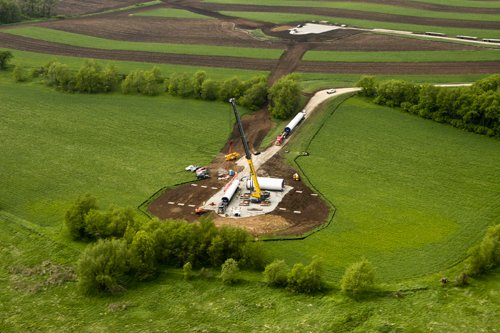
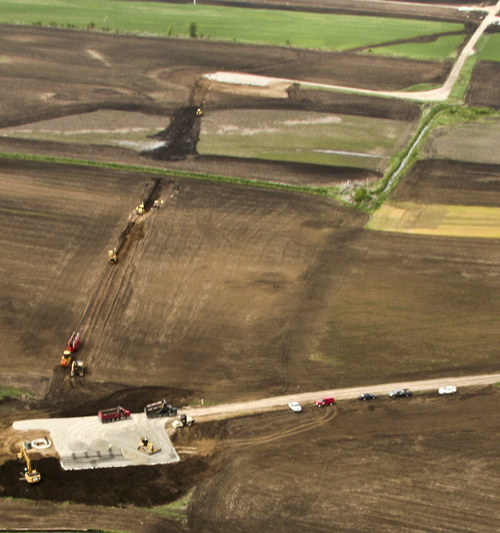
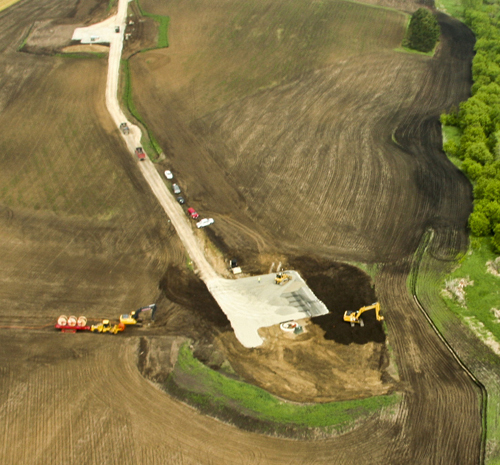
NEXT STORY: From Rock County, WI
SPRING VALLEY CONSIDERING BAN ON WIND TURBINES
SOURCE: The Janesville Gazette, gazettextra.com
June 4, 2011
By GINA DUWE
SPRING VALLEY TOWNSHIP — Town officials in Spring Valley are considering a new moratorium on wind turbines after the largest wind company in North America inquired about town wind ordinances.
The town board will discuss and likely vote on a moratorium at its Monday, June 13, meeting, Clerk Judy Albright said.
Spring Valley is among several area townships that wrote wind moratoriums while new rules to regulate wind projects less than 100-megawatts are decided at the state level.
Town officials discovered their previous moratorium expired Dec. 1 after Ted Weissman of NextEra Energy recently inquired about ordinances related to wind development and the process for placing a met tower.
A met tower gathers weather data to help wind developers determine if a site is good for development.
Weissman said he couldn’t comment but the company was looking at the area and hadn’t made any decisions. A company spokesman, however, said NextEra is not pursuing a met tower in Rock County.
Spokesman Steve Stengel said Weissman might have conducted some inquiries, but “we are not proposing it at this point,” he said. “What may or may not happen in the future (is) all speculation.”
NextEra owns and operates two wind farms in Wisconsin: 36 turbines at Butler Ridge Wind Energy Center in Dodge County and 20 turbines at Montfort Wind Energy Center in Iowa County.
Neighboring townships Magnolia and Union became possible sites for wind turbines a few years ago, and one met tower was placed in each town to gather data.
A spokeswoman for Acciona, the company that eyed those townships, said this week it is not pursuing “the early stage development project in Union and Magnolia. This enables (Acciona) to focus efforts and resources on other projects that are a better fit for their portfolio.”
Developers would be interested in hooking into the major transmission line that runs east-west through the northern part of Spring Valley, town officials said.
Smaller wind projects are permitted through local ordinances until lawmakers enact statewide rules.
Under state law, the Public Service Commission has to develop the rules, and a committee worked through most of last year to write the rules. When the rules were set to take effect in March, Republican lawmakers suspended them. It’s now up to legislators to approve new rules by May 2012 or the suspended rules would go into effect, a PSC spokesman said.
Republican Sen. Frank Lasee has proposed a bill that would add additional requirements to the PSC rules. The bill was referred to the Committee on Energy, Biotechnology and Consumer Protection, but no hearing is scheduled.
If you go
The town board will discuss and likely vote on a wind moratorium at its 7 p.m. meeting Monday, June 13, at the Orfordville Fire Department, 173 N. Wright St., Orfordville.
5/31/11 Wind Farm Strong Arm Chapter 4,358: From Ontario: Message to wind company AND Columbia county towers going up.
FROM ONTARIO
'GET OUT'
“You’re fighting a losing battle, just get out,” one resident shouted.
The company has received approval from the city to build eight turbines on the mountain range, after threatening a $126-million lawsuit when city officials in October rejected the location of several turbines.
Instead, community members lined up to voice their opposition to the project. Some told stories about what the mountain meant to them and others gave promises to stand against Horizon no matter what.
“You’re fighting a losing battle, just get out,” one resident shouted.
Jordan Morriseau, 30, usually hunts in the fall and said the turbines would impact his traditional hunting grounds and cause damage to endangered species that live on and around the mountain. He’s fighting against the project for environmental and cultural reasons, he said.
“That’s prime moose habitat up there,” Morriseau said. “We live off moose, it’s one of our main foods. The wind farm would be detrimental to our way of life.”
The company has received approval from the city to build eight turbines on the mountain range, after threatening a $126-million lawsuit when city officials in October rejected the location of several turbines. The project must still meet the standards set out by the province, through a renewable energy approval application. The province has already rejected Horizon’s REA application once.
Alex Legarde shared Morriseau’s concerns about the project. Legarde said he had questions he wanted answered, wondering if building the turbines would destroy hunting grounds. He’s concerned because hunting and trapping are his livelihood, he said.
Legarde hoped the project wouldn’t go through, he said.
Shane Wells, 31, went to the mic to speak a few times. He said he doesn’t know much about wind turbines, but he does know his community doesn’t want them and felt the two spokespersons for the company didn’t care what the community had to say.
“They could have put an audio recorder down and said see you all tomorrow and I`ll take that back to my boss,” Wells said. “I`ll give them the recorder of what was said. Oh they don’t like it, well just throw it away.”
Wyatt Bannon, one of organizers of the meeting, said he’s just one voice of many representing people who oppose the project. Horizon Wind is trying to build in an area that is sacred to the community and that development has to stop, he said.
No matter Horizon decides, the community is prepared to do to stop them, he said.
“We`ll do whatever it takes,” Bannon said. “We will not let it happen. Anybody to even consider putting those things up in such a pristine area are ignorant to everything people have worked. You don’t go into a watershed. That’s a no-brainer. It’s to protect the water. For these guys its money but for us it’s a lot more. It’s life.”
Following the meeting, officials with Horizon Wind weren’t available for comment.
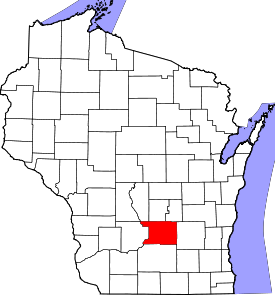
From Columbia County
WIND FARM TOWER SEGMENTS READY TO GO UP
May 31, 2011
By Lyn Jerde
“We’re building a project that not everybody wants in the community,”
TOWN OF SCOTT — How’s this for irony? The construction of the state’s largest wind energy facility is on hold, on account of wind.
The towers - the lower two components of them, anyway - were supposed to start piercing the skyline of northeastern Columbia County this week.
Instead, the components were, as of Thursday morning, lying on their sides, while the anemometers at the top of the cranes clocked wind speeds at about 40 mph. That’s about 15 mph too brisk for the safe construction of the towers.
It’s no surprise to Mike Strader of We Energies that breezes can get a tad gusty in these parts. That’s a key reason why We Energies is building the 90 turbine towers that will comprise Glacier Hills Wind Park on about farmland occupying about 17,300 acres in Columbia County’s towns of Randolph and Scott.
But, if the wind gusts to 25 mph or more, as it has all week, it’s not safe to erect the towers.
“What we can’t do is what we would love to do - put up those towers,” Strader said.
Starting Monday, plans had called for the arrival of the components of eight towers per day. The four segments of each tower would arrive, one at a time, from Manitowoc on trucks with about eight axles to distribute the weight evenly.
Many of the turbine blades have already arrived by rail from Colorado. Most are being stored, for now, on a town of Courtland parcel approved by Columbia County’s planning and zoning committee as a temporary staging area for the Glacier Hills project.
We Energies spokeswoman Cathy Schulze said that, for the most part, gawking at the construction will be discouraged, for the safety of the public and the workers, and because much of the technology is proprietary.
But the curiosity is understandable, she said, and an open house Wednesday is intended to satisfy that curiosity.
“A lot of people want to see these things,” she said. “This is a very good way let people get up close, without jeopardizing themselves and others.”
Strader said it had been hoped that at least the bottom two sections of a tower located near the construction office on Highway H, in the town of Scott, would have already been up by the time open house guests arrive Wednesday.
That doesn’t seem likely, given recent windy conditions, but it’s possible that people could see the components hoisted up Thursday.
Starting in the southeast quadrant of the construction area, Strader said, the base and “lower mid” segments of towers will be put up first.
The base component can be identified by a flange that sticks out around its bottom circumference. That’s the part that will be in contact with the ground, and held in place by grouting.
About six weeks after the bottom two segments of a tower go in, the top two segments will be installed. Also installed will be the nacelle (an enclosure at the top of each tower that contains the generator and transformer), the hub and the three blades.
The project is due to be finished in December, Strader said. He added that the wind delays so far have not put the project too far behind schedule - though there may be times when weather-delayed weekday work might have to be made up on Saturdays.
And yes, he said, some area people have let Glacier Hills construction workers know - sometimes by honked vehicle horns or shouts from vehicle windows - that they’re not happy about having 90 400-foot towers going up near where they live.
At the public hearings held before the Public Service Commission of Wisconsin authorized the project - with conditions - residents raised health-related concerns. Concerns include low-level noise and shadow flicker, as well as loss of TV reception, dangers to birds and bats and challenges for landing helicopter ambulances in the project’s vicinity.
“We’re building a project that not everybody wants in the community,” Strader said. “But, if alternative energy is to be produced in Wisconsin, then wind is one of the most viable resources.”
Want a closer look? Open house set Wednesday
The public is invited to take a closer look Wednesday at the construction of Glacier Hills Wind Park - including the big components of the 90 wind turbine towers that are going up in the towns of Scott and Randolph.
We Energies will have an open house from 3 to 7 p.m. Wednesday at the Glacier Hills construction office, N7844 Highway H, about a half-mile south of Highway 33 in the town of Scott.
In addition to viewing components and construction equipment, participants may sign their names to a turbine blade.
Officials of We Energies will be there to answer questions about the Glacier Hills project.
By the numbers
14: The approximate diameter, in feet, of the hollow space inside one of the Glacier Hills Wind Park towers, where there’s a ladder by which maintenance workers can access the towers.
138: The weight, in tons, of each completed tower.
148: The length, in feet, of each of the three turbine blades on each tower.
410: The height, in feet, from the ground to the top of the highest-reaching blade.
3: The number of quality checks that each turbine must pass before it’s operational. The turbines also will be inspected for safety periodically once they start generating electricity.
4: The number of sections in each tower.
56: The number of miles of underground trenching for the electrical distribution system within Glacier Hills. A lot of that is along Highway 33 just west of Cambria.
8: The number of axles on a truck that hauls a single segment of a turbine tower.
100 to 105: The number of feet high that the bottom two components of a tower - the base and the “lower mid” - stand once they’re assembled.
2: The number of towers per day that We Energies had hoped to build, starting Monday.
0: The number of towers that have been built as of Thursday.


